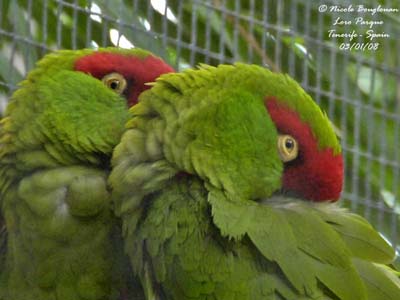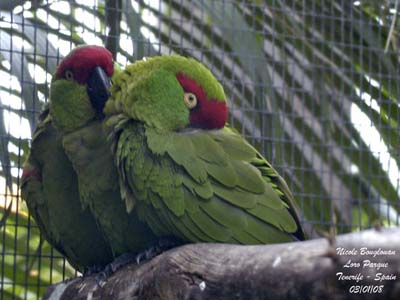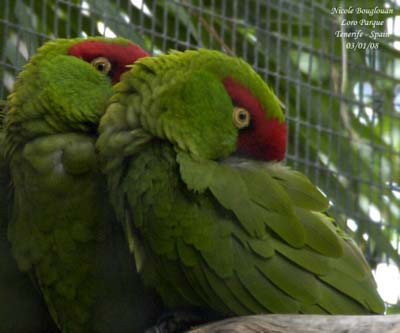
Thick-billed Parrot
Rhynchopsitta pachyrhyncha
Psittaciforme Order – Psittacidae Family
BIOMETRICS:
Length: 38 - 43 cm
Weight: 315 - 370 g
LONGEVITY: About 40 years
DESCRIPTION:
Thick-billed Parrot is an Endangered species.
Both sexes are similar. Adult is a medium-sized parrot, with long wings and short tail. It has bright green plumage overall.
On the upperparts, we can see the red bend of the wing. Wings are slightly darker than the body.
On the underparts, underwings show yellow greater coverts and brown flight feathers. Undertail feathers are brown too. Thighs are red.
On the head, forehead and forecrown are red. We can see a broad red stripe above the eye, from lores to ear coverts. The area below the eye, including cheeks and ear coverts, is yellowish-green.
Hooked, strong bill is large and thick, and blackish in colour. Eyes are orange-yellow to amber, with dull yellow bare eye-ring. Legs and feet are grey.
PROTECTION / THREATS / STATUS:
Thick-billed Parrot is an Endangered species. This species is highly threatened by deforestation and destruction of the pine forests in Sierra Madre. Lack of these pine forests means lack of nesting sites and feeding areas for Thick-billed Parrots and all the species living there.
Deforestation is going on for cattle and agriculture extension, and this parrot has become uncommon in its very restricted range.
Introductions into the USA have been unsuccessful. This species is also threatened by illegal pet-trade.
Efforts are in progress to breed these parrots in captivity, in order to reintroduce them again, because before their disappearance in USA, they bred after their introduction. But the birds were killed by predators, mainly raptors. In addition, these parrots had not developed flock behaviour which is necessary for their safety, and the possibilities for nesting were very low, by lacking of large enough cavities. Protection of the habitat is also in progress.
Fr: Conure à gros bec
All : Kiefernsittich
Esp : Cotorra Serrana Occidental
Ital : Pappagallo beccoforte
Nd : Dikbekpapegaai
Text and pictures by Nicole Bouglouan
Sources:
HANDBOOK OF THE BIRDS OF THE WORLD volume 4 by Josep del Hoyo, Andrew Elliot and Jordi Sargatal – LYNX EDICION – ISBN 8487334229
PARROTS OF THE WORLD – An Identification Guide – by Joseph M. Forshaw – Princeton University Press – ISBN 0691092516
BirdLife International (BirdLife International)
What Bird-The ultimate Bird Guide (Mitchell Waite)
Wikipedia (Wikipedia, The Free Encyclopedia)

Juvenile lacks the red broad stripe above the eye. It only has red forehead and forecrown. Carpal edge is green, and thighs are less red than in adults.
It has horn-coloured bill, with brownish-grey base of upper mandible. Eyes are brown.
Similar species: The Maroon-fronted Parrot (Rhynchopsitta terrisi) is darker green with maroon forecrown and supercilum, and duller yellow-green underwing coverts. This one lives in small area in north-eastern Mexico, and is classified as Vulnerable.
VOICE: SOUNDS BY XENO-CANTO
Thick-billed Parrot is very noisy, and utters a variety of harsh, rolling calls. It gives raucous “scronk”, and utters series of “haw-haw-haw-haw” when flying. When in flocks, they utter sharp “kuk-kuk-kuk-kuk”, producing cackling sounds. We can also hear a rolling “aa-ahr”. In flight, they call to each other with a kind of children laughing.
HABITAT:
Thick-billed Parrot lives mainly in pine forest at high elevation, from 1500 to 3400 metres. They need these trees for feeding and nesting, and they prefer old forests rather than second growths. They can be found both in Pinus forests, or mixed Pinus-Quercus woodlands in altitude, but sometimes in lowlands if large pine forests are available. It largely depends on pine, spruce and fir for feeding and nesting.
RANGE: Thick-billed Parrot lives in restricted range in north-western and Central Mexico, in the Sierra Madre Occidental.
This species was present in south-west USA last century, but it disappeared and its movements were unknown. Introduction in Arizona in the 1980s was unsuccessful because the parrots were killed by predators, mainly raptors.
In addition, some of these parrots migrate, but their destination is still a mystery. They leave the northern Sierra Madre Occidental from autumn to spring. Some birds have been recorded southwards, in Durango – Mexico.
BEHAVIOUR:
Thick-billed Parrot feeds mainly on seeds of several pines such as Pinus arizonica, and Pinus ayacahuite. It also takes acorns and seeds of fruits and vegetables. They often feed in groups. While the flock is feeding, some sentinels scan the sky for birds of prey, in order to alert the group of potential danger.
Thick-billed Parrot is highly social. This behaviour is very important for the birds’ safety, and they maintain contact between them.

Thick-billed Parrot migrates, leaving the breeding ranges in autumn and flying southwards until the next spring. Flocks are observed while they wander within the breeding area, probably for food and availability of pine seeds.
They roost in tall trees at communal night-time roosts in forests. Usually, the parrots gather in trees fairly close to the roost before to join the tall trees for the night. They preen each other; they squabble and move within the trees, climbing up and down the branches before to sleep.
In the early morning, Thick-billed Parrots leave the roost in small groups, and fly high to their feeding areas. They are mainly arboreal, feeding in the pine trees, but they can come to the ground for fallen cones.
Thick-billed Parrot uses its feet and its powerful bill, in order to manipulate cones and seeds. It also grasps, climbs and swings thanks to its bill, for moving into trees, and then, it clips pine cones from the branches. To strip an entire cone of seeds can take about twenty minutes.
During courtship, the male regurgitates food to the female. Mates also perform mutual preening.
FLIGHT:
Thick-billed Parrot has powerful direct flight, performed with shallow wing beats. Its strong flight can allow this bird to escape from raptors attacks. The parrot dives towards the ground, and flies into trees were birds of prey can’t enter. When in migration, this species is able to make long-distance nonstop flights. These parrots can often exhibit V or line formation while in flight.
REPRODUCTION:
Breeding season occurs from May to August, and coincides with pine seeds abundance. Breeding and nesting behaviours take place at high altitudes, where Thick-billed Parrot finds its preferred seeds. When pair is formed, the birds start to select nest-site and cavities.
This parrot nests in cavities in dead or decaying trees, and often uses abandoned old woodpecker holes. It enlarges the entrance by chewing bark and wood with its strong bill. Sometimes, several nests can be found in the same tree.
This species is monogamous and pairs for life.
Female usually lays 2 to 4 creamy coloured eggs. Incubation lasts about 24 to 30 days, by female, while the male forages and feeds her at nest by regurgitation.
Chicks are fed first by the male, and stay in the cavity for two months, before to start some flight. Female broods them constantly the first three weeks, before they are feathered. Then, she joins the male for foraging and feeding them.
Young are independent at seven months of age, and the nest is abandoned by the family.
DIET:
Thick-billed Parrot feeds mainly on pine seeds, but also on acorns, fruits and usually plant matter. Prunus fruits and vegetable seeds are taken as food supply.
